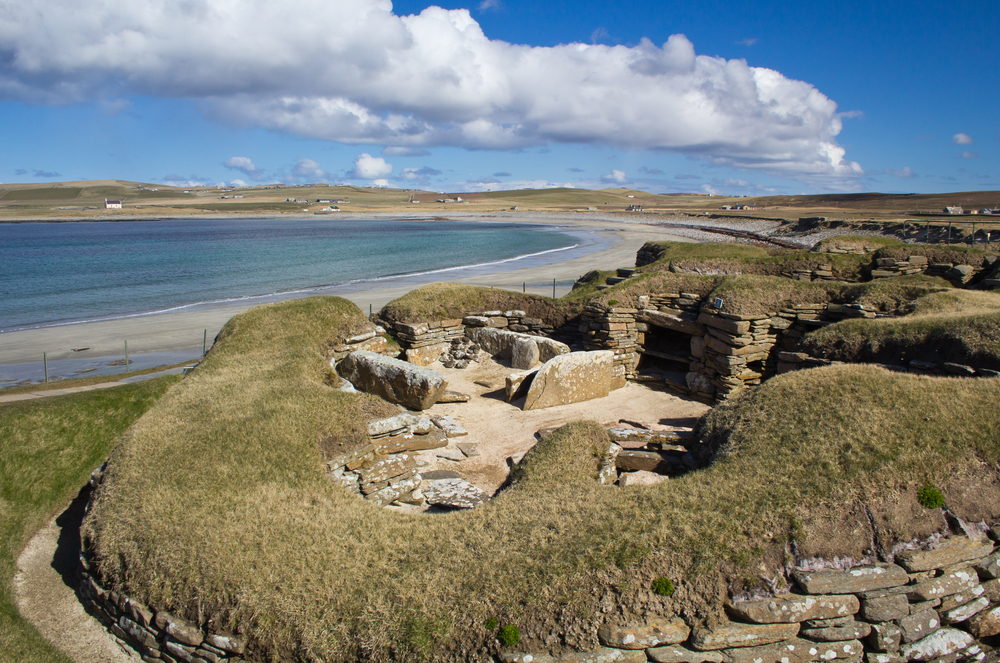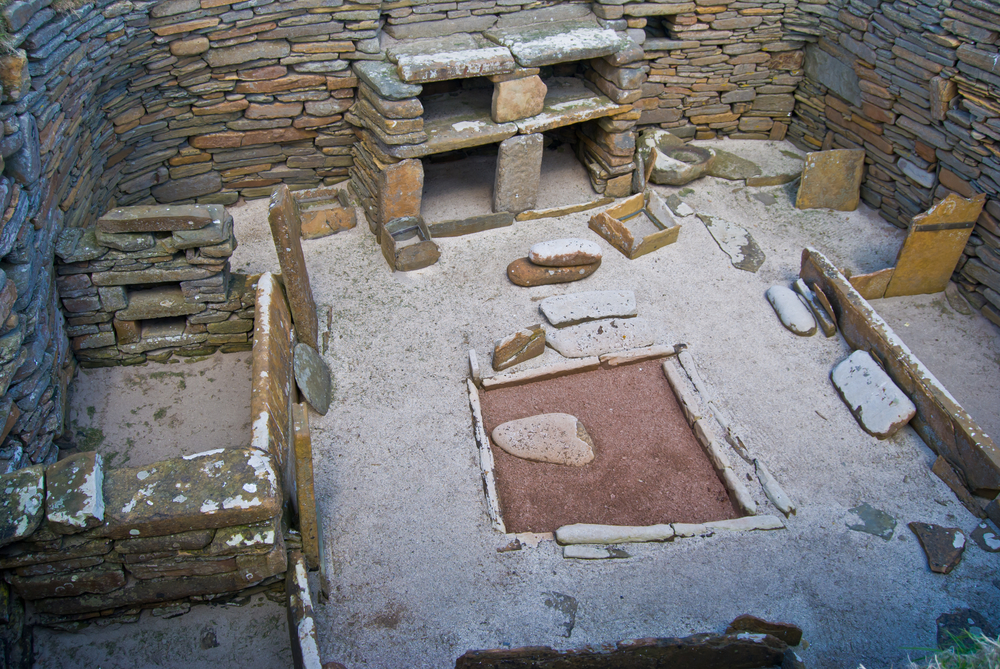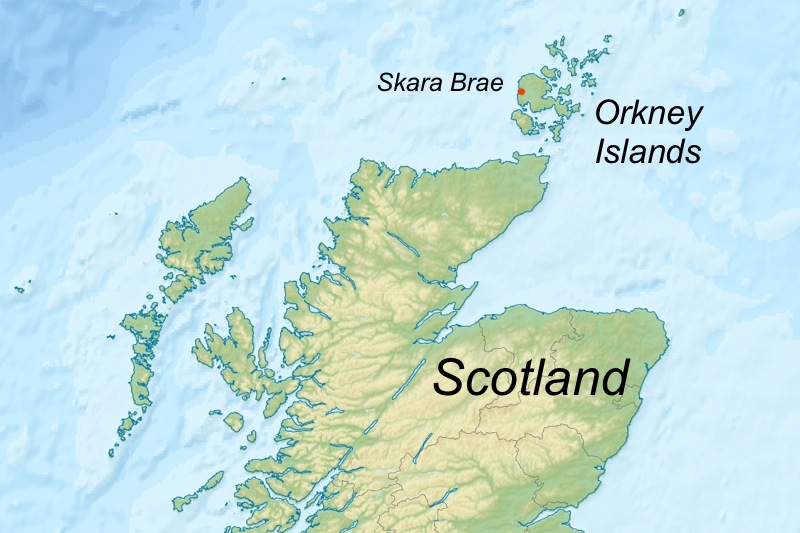Skara Brae: Prehistoric Scottish Village

Skara Brae is a prehistoric village that was in use between roughly 3100 B.C. and 2500 B.C. Located on the west coast of the main island of Orkney, in Scotland, what makes the site special is its good state of preservation. Visitors can still see the furniture of the stone houses that people used 5,000 years ago.
After it was abandoned, it was covered with sand dunes and wasn’t discovered until A.D. 1850, when a ferocious winter storm blew part of the turf off the ruins. Located within walking distance of a stone circle at Brodgar, the village was part of a prehistoric landscape on Orkney that included other stone villages, farmsteads, tombs and stone circles.
While the village’s buildings were modified throughout its 600-year history, the site was never large and consisted of about 10 houses that, in total, probably housed no more than 100 inhabitants at any one time. Eventually, a series of roofed passages were constructed that made it easy to go house-to-house in the middle of winter.
“The villagers were real neighbors living cheek by jowl, their houses connected by walled, sometimes decorated, alleyways,” said Simon Schama, a professor at Columbia University, in a BBC documentary aired in 2000. “It’s not too much of a stretch to imagine gossip traveling down those alleyways after a hearty seafood supper.”
Today, Skara Brae is by the sea although in prehistoric times it would have been a few miles from the coast. Erosion has led to the coast of Orkney moving closer to the site over the millennia.
Stone houses
The houses at Skara Brae each consist of one room made of locally available stones that were held together with a “sticky midden material that provided both insulation and stability,” writes Caroline Wickham-Jones, a lecturer at the University of Aberdeen, in her book “Between the Wind and the Water: World Heritage Orkney” (Windgather Press, 2006).
Each house had a central hearth where a fire would have kept the inhabitants warm. The houses also had stone beds that would have been softened with furs, straw or dry seaweed. Archaeologists found that the houses usually had one large stone dresser that typically had three shelves divided into two bays, Wickham-Jones writes. The houses even had open areas with drains that would likely have been used as prehistoric toilets.
Get the world’s most fascinating discoveries delivered straight to your inbox.
How the houses were roofed is a mystery; it’s possible that driftwood, thatch, turf, whalebones or other material was used. The roof may have contained a hole that allowed some of the smoke to escape.
The village’s inhabitants used a sophisticated array of stone tools. “Some are heavy tools such as mattocks and shovels, others are more delicate, such as pins and needles,” Wickham-Jones writes.
Additionally, archaeologists have found beads that could have been fastened into necklaces, as well as pieces of pottery, some of it decorated with patterns, providing a fleeting glimpse into the art created by the villagers.
A communal lifestyle
How the inhabitants of Skara Brae organized themselves is a mystery with few clues for researchers to work with. Presumably, each house held an extended family that included grandparents and perhaps other relatives.
Archaeologists have found no evidence of an elite residence at Skara Brae, which suggests that the people of the village made decisions in a communal way. However, within the houses “between the dresser and the hearth there is sometimes a block of stone,” good for sitting, writes archaeologist Anna Ritchie in her book “Prehistoric Orkney” (Historic Scotland, 1995). She writes that this could be a “seat of honour” of sorts.
Archaeologists do know that the villagers were connected to other inhabitants in Orkney and must have played a role in the rituals carried out at the great stone circles and other monuments on the island.
“They had contacts across Orkney and the great monuments at Brodgar and Stenness (both of which have stone circles) are likely to have played an important part in their lives, as did the tombs such as Maeshowe, where they could get in touch with the ancestors and where some of the community was buried,” writes Wickham-Jones.
A village workshop?
One puzzling house, given the rather bland name “house eight,” appears different from the others. It is not connected to the other buildings and has a porch, of sorts, by its entrance. It also has no beds or dressers but instead has many niches and recesses on the walls, writes Wickham-Jones.
Archaeologists cannot be sure what this structure was used for, although one possibility is that it was a workshop. Ritchie notes that it is one of only two houses “to be embellished by carved patterns on their walls.”
Bull’s head on a bed
While “house eight” is mysterious, “house seven” (the other house with carved patterns) is perhaps the strangest of all. When archaeologists excavated it, they found two human burials (both of adult females, Ritchie notes).
Furthermore, archaeologists found that “the skull of a bull lay in one bed, a bone dish full of red, ochre pigments lay on the floor (and) there was a cache of jewellery …” writes Wickham-Jones. She notes that this house continued to be used after the rest of the village was abandoned. These burials “may have been inserted towards the end of its (the house’s) use.”
Towards the end of Skara Brae’s existence, its soil was becoming infertile as sand dunes advanced toward it. The settlement was gradually abandoned and the burials at house seven may have been a final act.
Skara Brae today
In the millennia since Skara Brae was abandoned, the sea has advanced ever closer to the settlement. A sea wall now protects the ruins and, in 2009, the BBC reported that efforts were under way to strengthen it.
“Waves have affected a section of concrete on which the protective walling was built, which could lead to more damage,” the news service reported. Historic Scotland, an agency of the Scottish Government, is now in charge of the site and is leading the project.
In the century ahead, Skara Brae, like other coastal sites around the world, may be threatened by rising sea levels caused by global warming, a modern-day problem that threatens a site that has withstood 5,000 years of time.

Owen Jarus is a regular contributor to Live Science who writes about archaeology and humans' past. He has also written for The Independent (UK), The Canadian Press (CP) and The Associated Press (AP), among others. Owen has a bachelor of arts degree from the University of Toronto and a journalism degree from Ryerson University.




